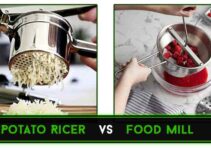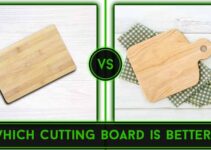With more people shying away from using harsh chemicals for the purposes of cleaning around the house, vinegar has emerged as a popular alternative for many homeowners.
However, you’re not always going to have a container of vinegar available in your home. Furthermore, there are also homemakers who are simply not fond of using that aforementioned substance for cleaning due to their own preferences. That is especially true if they want to clean a coffee maker.
If you’re dealing with either one of those issues, then you need to know how to clean a coffee maker without vinegar. The good news is that there are numerous alternatives you can use in the place of vinegar if you want to effectively clean your trusty coffee maker and you may also have them lying around your home already.
Please read on to learn more about those alternatives and how to use them for cleaning the coffee maker.
Why Should You Clean Your Coffee Maker?
Before we dive into the alternatives you can use for cleaning a coffee maker, let’s talk first about why you need to clean that household appliance.
The first reason for why you should regularly clean your coffee maker is for health reasons. If you continually put off cleaning your coffee maker, then you’re allowing it to turn into a high-moisture environment whenever it’s not in use.
The problem there is that high-moisture environments are conducive to the growth of mold and bacteria infestation. Needless to say, you don’t want those things in your coffee.
Furthermore, if you want to enjoy the best-tasting coffee each and every morning, you need to clean that appliance on a regular basis. By failing to clean your coffee maker regularly, you’re depriving yourself of some delicious cups of coffee.
12 Ways How to Clean a Coffee Maker without Vinegar?
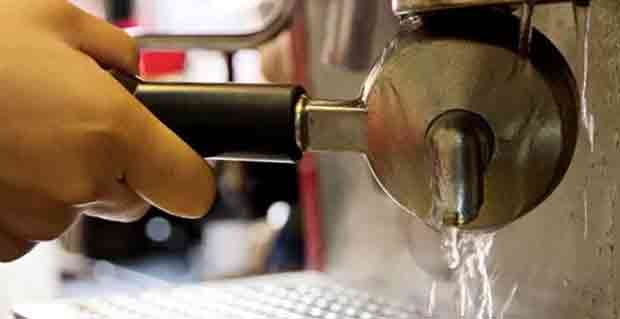
1. Make Use of Some Lemon Juice
Lemon juice is a highly acidic substance, just like vinegar is, and yes, it can be used for cleaning your coffee maker. You can even use some lemon juice in a container if you don’t have fresh lemons on hand.
The Process:
- Fill the coffee maker halfway with water and run a cycle
- Grab a cup and fill it with half a cup of water and half a cup of lemon juice
- Grab a cup and fill it with half a cup of water and half a cup of lemon juice
- Open the reservoir of your coffee maker and put the water and lemon juice solution inside
- Allow that liquid mixture to stay in the reservoir for about 15 minutes
- Place a clean filter into the coffee maker and then start a new cycle with the liquid mixture
- Replace the mixture with fresh water and then run a new cycle
- Wipe the interior components of the appliance using a sponge that contains some lemon juice
- Wash the rest of the parts with soap and water and let them all dry before reassembling
2. Get Rid of Dirt and Grease Using Baking Soda
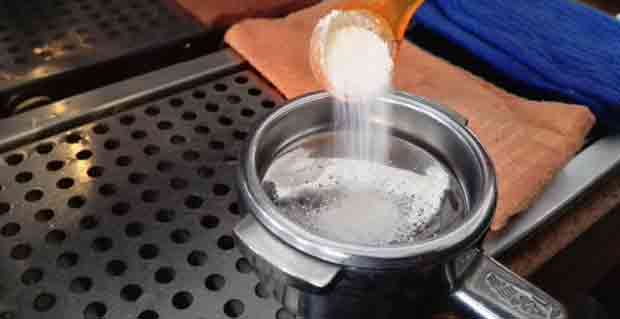
Baking soda has often been used with other substances for cleaning purposes. You can do that again if you want to thoroughly clean your baking soda.
The Process:
- Take out the coffee filter and leave it on the counter
- Pick up the coffee pot and then fill it with a cup of lukewarm water
- Sprinkle in a quarter cup of baking soda into the coffee pot and stir it in until it dissolves
- Take out the baking soda solution and pour it into the coffee maker’s reservoir
- Put the coffee pot back in its original place
- Activate the coffee maker now and let it go through an entire brew cycle
- Pour out the dirty water that has made its way to the coffee pot
- Fill the reservoir with fresh water
- Continue running cycles until the water that makes it into the pot runs clear
3. A Little Bit of Bleach Can be Helpful
It’s important to say right away that you shouldn’t use bleach if you have an automatic coffee maker. Otherwise, just using a bit of this household item should help you clean the coffee maker more effectively.
The Process:
- Prepare four cups of water in a container and add just two tablespoons of bleach to that
- Mix the bleach into the water carefully
- Take out some filter paper and then use that to line your coffee maker
- Pour the liquid mixture into the coffee maker and follow it up with some more water
- Turn on the coffee maker now and let it go for a few minutes before unplugging it
- Take some time to thoroughly wash the coffee maker to make sure that it is completely free of bleach
4. Cream of Tartar is a Surprisingly Effective Cleaner
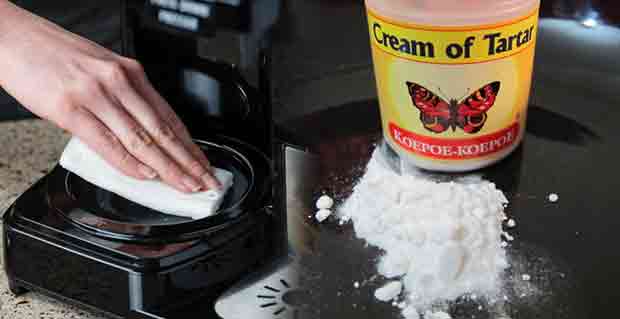
The acidic nature of cream of tartar is useful not just for making food more flavorful. It can also be utilized for cleaning purposes.
The Process:
- The first step is to fill up the coffee pot with water along with three tablespoons of cream of tartar
- Now, take the time to dissolve the cream of tartar in the water by stirring it in.
- Allow some water to go through the coffee maker
- Let the coffee pot fill up with water and then allow it to cool down for a while
- Wash the pot using a sponge and don’t forget to thoroughly rinse it as well
5. Hydrogen Peroxide is Useful for Disinfecting a Coffee Maker
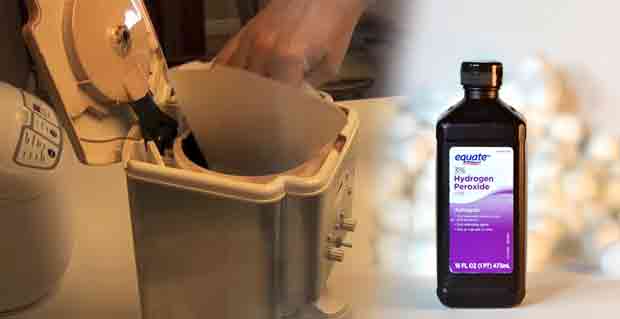
If you’re coffee maker has already been affected by mold and/or bacteria, then you will likely need to disinfect it. Hydrogen peroxide is useful for that very purpose.
The Process:
- Pour about a cup of hydrogen peroxide into the coffee carafe
- Add water to the coffee carafe and then pour that mixture into the coffee maker
- Take the coffee pot now and position it under the brewing basket
- Activate the coffee maker and let it go through a cycle
- Continue putting the coffee maker through cycles but only use water
- Keep the cycles going until you have removed all of the hydrogen peroxide
6. CLR Can Get Rid of Calcium and Rust Buildup
Calcium, Lime, and Rust remover is an effective cleaning item. Unsurprisingly, it is also useful if you want to remove the calcium and rust buildup on your coffee maker. By the way, you should also avoid using CLR on coffee makers that permanently hold water.
The Process:
- Begin by running some clean water through your coffee maker to get rid of any loose bits that have been left behind
- Grab the CLR now and mix that with eight parts of water
- Take that mixture and place it into the coffee maker’s reservoir
- Complete a brew cycle with the mixture in the reservoir
- Continue to run the coffee maker using clean water until the CLR is gone
7. Denture Tablets Can Remove Mineral Deposits
If you just happen to have some denture tablets in your medicine cabinet, take those out because they can be used on your coffee maker.
The Process:
- Put some warm water into your coffee pot’s container
- Drop two denture tablets into the warm water and then allow them to dissolve completely
- With the tablets dissolved, go ahead and run a cycle
- Run some more cycles using warm water until the traces of the denture tablets are removed
8. A Simple Cleaning Method Using Dishwashing Liquid
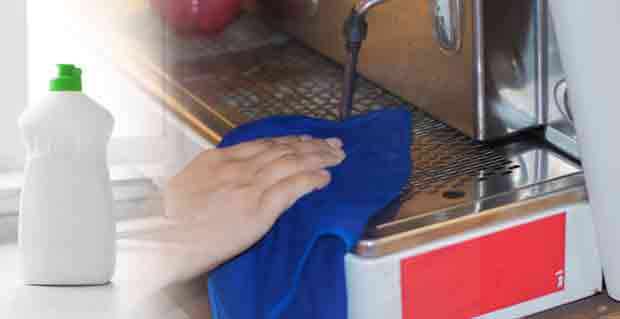
Dishwashing liquid can be used for quickly cleaning the coffee maker.
The Process:
- Remove all the detachable parts of your coffee maker
- Clean those parts individually using the dishwashing liquid and water
- Allow the parts to dry off before reassembling the coffee maker
9. Cleaning a Coffee Maker Using Vodka is Possible
Vodka is not just a beverage that can be used by adults looking to unwind after a long day. This beverage is also useful if you are looking to clean your coffee maker because of its alcoholic content and the fact that it features no distinctive odor or taste. Beyond cleaning up your coffee maker, vodka is also going to be helpful if you want to remove that plastic smell that may be coming from the reservoir.
The Process:
- Open up the coffee pot of the coffee maker and then proceed to fill it with a combination of vodka and water
- Turn on the coffee maker next and let the vodka work
- You now have to run your coffee maker again but just use some fresh water this time
- Run about two more cycles just to make sure that the vodka is no longer in the coffee maker
10. Muriatic Acid is a Strong Substance that Can be Used on the Coffee Maker
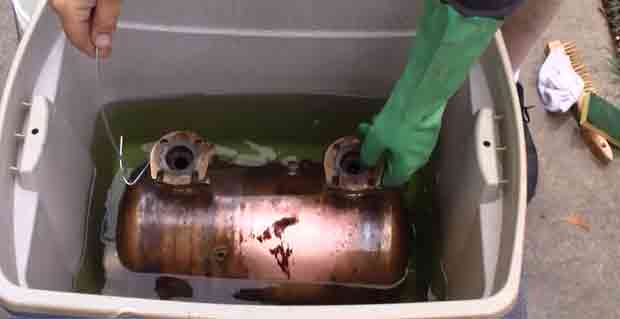
Muriatic acid is yet another substance that can clean your coffee maker, but you need to be extra careful if you decide to use it. Purchase some gloves and safety glasses if you intend to use it and remember to always transfer the muriatic acid into water instead of the other way around.
The Process:
- Dilute the muriatic acid with water before you start using it to clean
- Mix one part of muriatic acid with four parts of water while remembering to add the acid to the water
- Set the muriatic acid mixture aside
- Fill a separate bucket with water and put baking soda in it
- Remove all the detachable parts of your coffee maker
- Take the parts and place them inside the muriatic acid mixture
- Let them sit there for about five minutes
- Take out the parts from the muriatic acid mixture and place them in the bucket with the baking soda
- Rinse off all the parts by using a lot of water
11. The Multi-Purpose Cleaner Known as Borax is Suitable for the Coffee Maker
There’s a chance that you’ve already used borax to clean different parts of your home in the past. Well, you should know that it can also be used on your coffee maker.
The Process:
- Add some water to the reservoir of your coffee maker
- Open up the reservoir again and add two tablespoons of borax this time
- Allow your coffee maker to go through a cycle with the borax and water mixture inside
- Run about four more cycles using just clean water to remove the traces of borax
12. Alka Seltzer is Useful Not Just for Relieving Heartburn and Indigestion
We often reach for Alka Seltzer tablets when we’re feeling some discomfort due to heartburn or perhaps indigestion. More often than not, after taking the Alka Seltzer, those problems do go away. You’ll be glad to know that Alka Seltzer is helpful not just for providing comfort but for cleaning as well.
The Process:
- Place two Alka Seltzer tablets in your coffee maker’s reservoir and then add two more to the filter container
- Put some cold water into the coffee pot now
- Turn on your coffee maker and let it go through an entire cycle
- Just allow the Alka Seltzer tablets to take effect
- Once the tablets have done their thing, add some clean water to the coffee maker
- Run two more cycles using the fresh water to remove the traces of the Alka Seltzer
- Wipe down the rest of the coffee maker to get rid of all the remnants of the tablets
As you can see, there are all kinds of items that can work to clean your coffee maker. You don’t always have to use vinegar and if you don’t like using that item at all, you don’t have to.
By using the different items and methods above, you can clean your coffee maker properly without ever using vinegar again.

